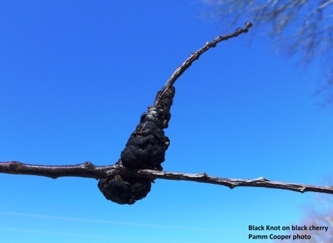Black knot, a serious disease of plums in Connecticut, is caused by the fungus Apiosporina morbosa (aka Dibotryon morbosum). Many American, Japanese and European plums are susceptible and it is also found on ornamental flowering cherry and plum trees. A major source of infection is the native American wild cherries that are common along the roadside. Severe infections can result in the death of branches and, eventually, the entire tree.
Symptoms
The black knot fungus causes elongated swellings or knots on infected branches. At first the knots, sometimes called galls, are greenish to light brown. Upon aging, they turn black and become quite hard. Initially, the knots are about an inch in diameter but, because they grow annually, they will eventually girdle the stem. This will result in the death of the upper portion of the stem. The knot will often be invaded by other fungi along with various boring insects.

Disease Cycle
Spores are discharged from mature knots during rainy periods in the spring. Young growth (under three years old) is very susceptible to infection. However, older branches can also be infected, especially if the bark has been damaged. Infection can be severe when temperatures are between 55º and 77ºF. The major infection period starts when the buds swell in the spring and continues until terminal growth stops or the supply of spores is exhausted.
Several months after infection has taken place, the knot begins to develop. At first it is a greenish swelling on the stem and by the following spring, the familiar black knot is present. The knot may produce spores at this time, but it usually takes two years for the knot to mature. In the spring and fall, the old knots are active, often growing several inches. This new growth is usually not noticed until the following spring. These knots will continue to produce spores until the branch is dead.
Control
On individual trees, a good control program consists of sanitation and protection. Because the wild cherries in the area are the primary source of inoculum, it is wise to remove them. Examine all the plum and cherry trees in late August and prune any knot found on the branches. Mature black knots should also be removed by cutting the stem 4 inches below the knot. All pruned material should be removed from the area and destroyed or buried. If left, the knots may be capable of shedding spores in the spring.

Spraying with a protectant fungicide is often necessary if the disease is to be controlled on the more susceptible varieties such as Stanley, Damson, Shropshire and Bluefre. Moderately susceptible varieties include Methley, Milton, Early Italian, Brodshaw and Fellenburg. Varieties slightly susceptible to black knot include Shire, Santa Rosa and Formosa, whereas President appears to be highly resistant.
Chemical control of the disease should start when the buds begin to swell, temperatures reach 55ºF or higher and the foliage remains wet for six hours or longer after a rain. It will be helpful to maintain a protectant layer of fungicide on the new expanding foliage and twigs until the terminals stop growing or the spores have been discharged. However, infection is greatest from the time the flower buds show pink until two weeks after bloom. During periods of heavy rain and/or rapid plant growth, it may be necessary to reapply the fungicide every seven days.
Despite good cultural practices, pests and diseases at times may appear. Chemical control should be used only after all other methods have failed.
For pesticide information or other questions please call toll free: 877-486-6271.
Edmond L. Marrotte, Consumer Horticulturist, & Dr. David B. Schroeder, Plant Pathologist
Revised by UConn Home and Garden Education Center 2019.